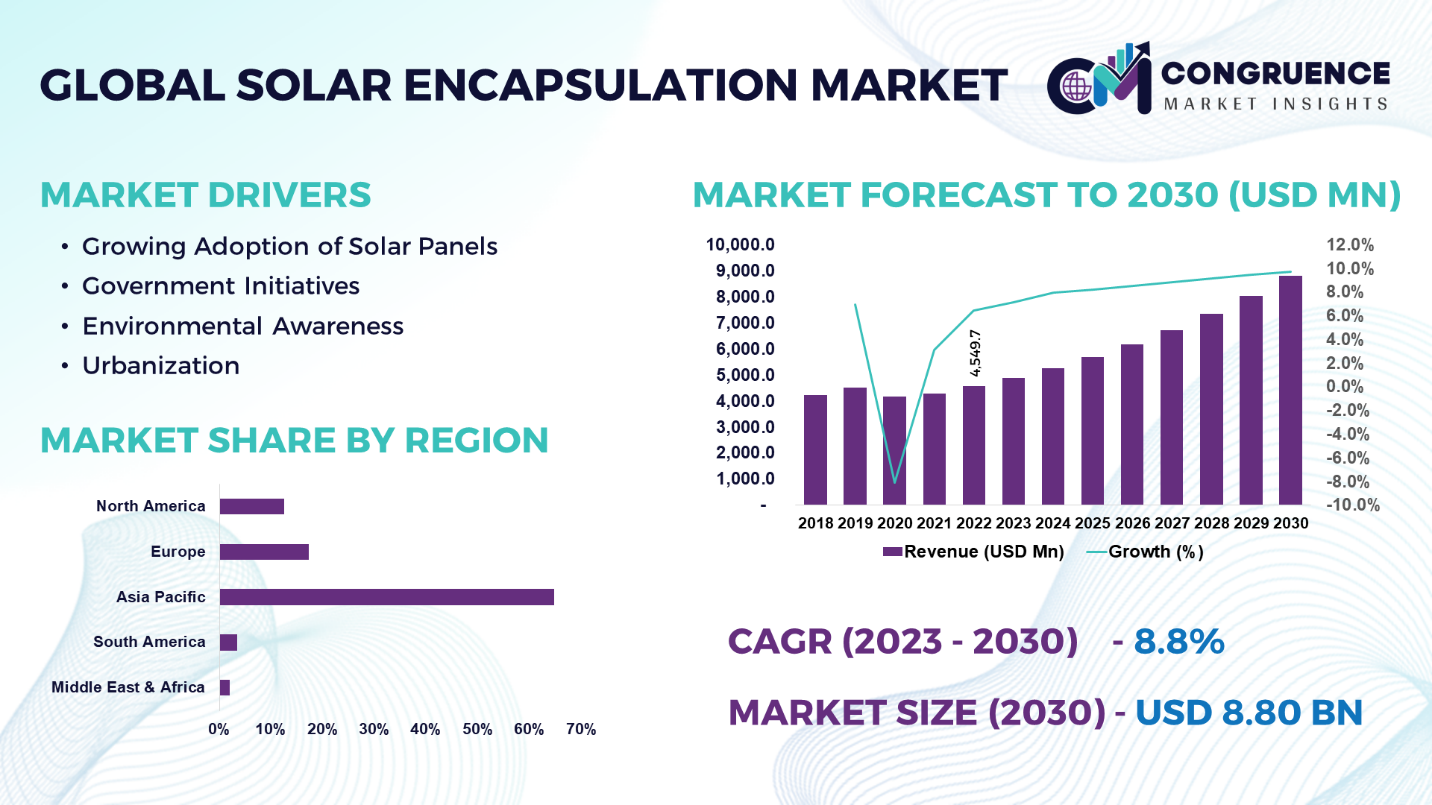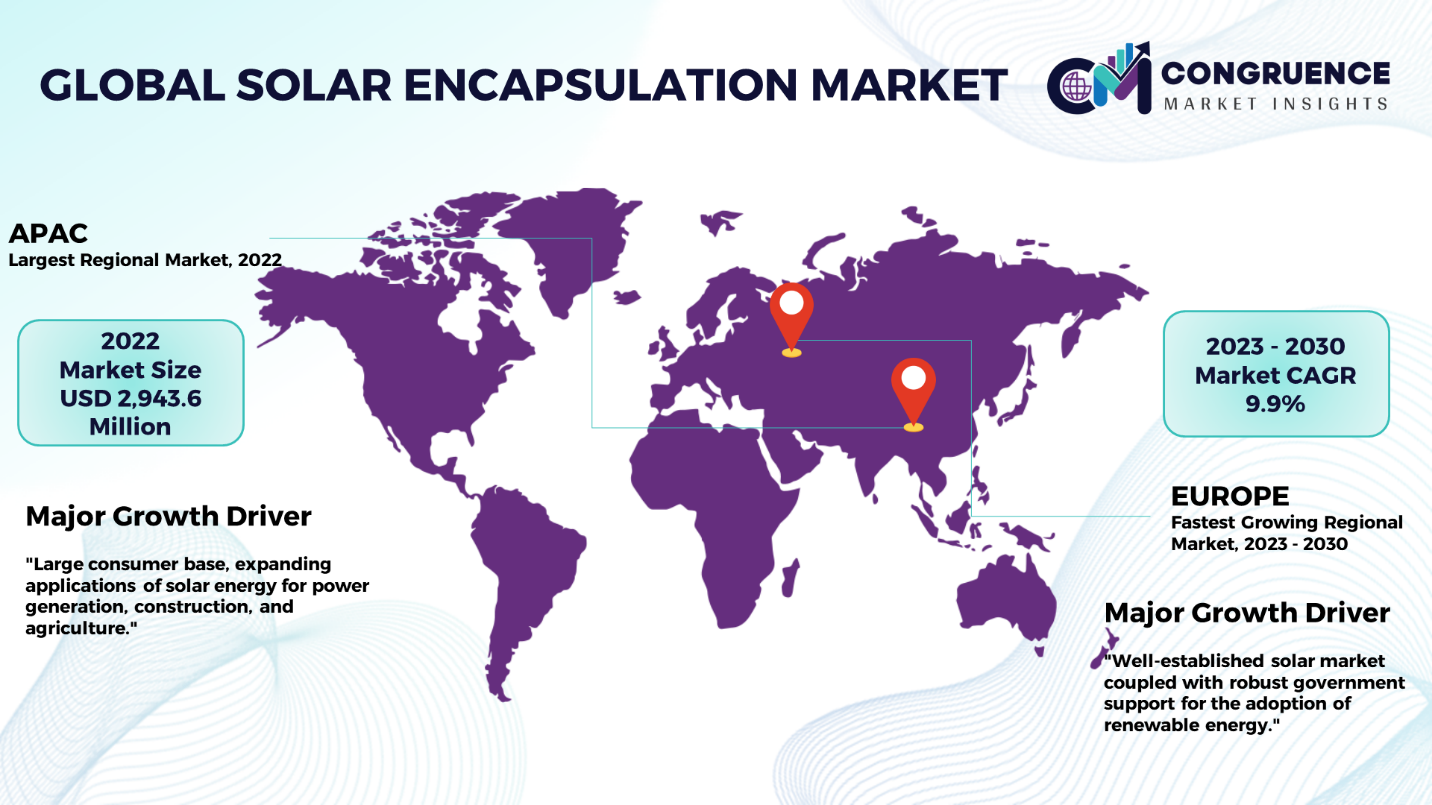Reports
The Global Solar Encapsulation Market was valued at USD 4,549.7 Million in 2022 and is anticipated to reach a value of USD 8,799.2 Million by 2030 expanding at a CAGR of 8.8% between 2023 and 2030.
Solar encapsulation refers to the process of protecting and sealing photovoltaic cells used in solar panels with polymeric materials to ensure the longevity and durability of the solar panels. Encapsulation is the critical process for the operational stability of PV cells and other internal components of a solar module. This encapsulation plays a crucial role in ensuring the long-term durability, efficiency, and reliability of solar panels in various weather conditions. It is a method of securing solar cells with a safeguarding layer of encapsulant material. This encapsulation shields the solar cells from moisture, dirt, and various pollutants that may lead to damage to solar cells. Solar encapsulation offers several benefits including, improved efficiency, enhanced safety, longer lifespan, low maintenance cost, and durability. The procedure includes laminating the solar cells with a thin layer of polymer, such as ethylene-vinyl acetate, non-ethylene vinyl acetate, UV curable resin or other materials. quilted blanket that has a natural or artificial filling and is covered by a removable cover. The market is influenced by factors such as growing adoption of solar panels, government initiatives, environmental awareness, and urbanization. The solar encapsulation market serves construction, electronics, automotive, and other industries.

Solar Encapsulation Market Major Driving Forces
Growing Adoption of Solar Panels: The global solar encapsulation market has witnessed significant growth due to widespread adoption of solar panels. The global shift towards renewable energy sources is a primary driver for the growing adoption of solar panels.
Government Initiatives: Many governments across the globe are implementing various strategies and initiatives to encourage the usage of solar energy. These initiatives encourage investments in solar projects and solar installations in several countries.
Environmental Awareness: Increasing awareness about environmental issues and growing emphasis on sustainability is a significant driver of the global solar encapsulation market. There has been a significant shift towards renewable energy sources, due to the growing environmental concerns around the globe.
Urbanization: The increasing urbanization plays a significant role in contributing to the growth of the global solar encapsulation market. The urbanization has increased demand for solar panels, which result in increased demand for solar encapsulation.
Solar Encapsulation Market Key Opportunities
Technological Advancements: Technological advancements in encapsulation materials and manufacturing process provide a significant opportunity for the market growth. The development of innovative materials that improve efficiency, durability, and light transmission can attract more consumers for the adoption of solar energy.
Cost Reduction: The cost reduction in solar modules by incorporating less expensive encapsulation technologies is anticipated to create profitable opportunities for the market expansion. Lowering the cost of encapsulation materials can make solar panels more affordable for both residential and commercial consumers, leading to wider adoption of solar energy.
Research and Development: Continuous research and development to increase the solar efficiency, and durability of solar cells is expected to create potential growth opportunities for solar encapsulation market. Growing demand for advanced and sustainable encapsulation solutions, leads to innovations in materials aimed at optimizing solar module performance and reducing environmental impact.
Solar Encapsulation Market Key Trends
· Technological advancement of solar encapsulation improving the efficiency, and durability of solar encapsulation materials
· The growing adoption of solar panels owing to the increasing demand for electricity across the globe
· The substantial shift toward renewable energy sources due to the growing environmental concerns and depleting conventional energy sources
· Development of low-cost encapsulation materials, such as cadmium telluride and amorphous silicon cells for boosting product demand
· Growing government initiatives to encourage renewable and energy-saving resources is a major trend in market
· Growing focus on sustainability and environmental responsibility is becoming increasingly important in market
· Integration of smart technologies such as sensors and monitoring systems, in solar encapsulation materials for improving the overall performance of solar panels
Region-wise Market Insights
Asia Pacific accounted for the largest market share at 64.7% in 2022 whereas, Europe is expected to register the fastest growth, expanding at a CAGR of 9.9% between 2023 and 2030.

Asia Pacific dominated the global solar encapsulation market in terms of market share and revenue. This is attributed to the factors such as a large consumer base, expanding applications of solar energy for power generation, construction, and agriculture in the region. In addition, increasing urbanization, growing industrialization, and increasing adoption of solar energy within the Asia Pacific region contributes significantly to the market growth. In North America, the demand is driven by a growing demand for renewable energy and increasing awareness about benefits of photovoltaic technology. Moreover, growing adoption of solar energy, technological advancement in solar panel manufacturing contributes to the market growth in North America. Europe has well-established solar market coupled with robust government support for the adoption of renewable energy. Europe emphasizes on eco-friendly and sustainable materials for solar encapsulations process. The Middle East and Africa has been witnessing a significant demand for solar encapsulation due to increasing government investment in renewable energy, in South America, the market is influenced by growing awareness about benefits of solar encapsulation.
Market Competition Landscape
The global solar encapsulation market is characterized by high degree of competition among a large number of manufacturers. Key players in the solar encapsulation market engage in strategies aimed at gaining a competitive edge. These strategies include product innovation, design differentiation, and the incorporation of sustainable and eco-friendly materials to meet evolving consumer preferences. Another key strategy involves cost-effectiveness, where players are focus on optimizing their production process and achieving economies of scale to offer solar encapsulation materials at a lower cost than other competitors. Furthermore, incorporation of advanced materials, innovative technologies, or unique manufacturing processes that enhance the performance and durability of solar encapsulation materials. Established brands leverage their reputation for quality and reliability to maintain market share, while newer entrants focus on disruptive innovations and unique selling propositions.
Key players in the global solar encapsulation market implement various organic and inorganic strategies to strengthen and improve their market positioning. Prominent players in the market include:
· 3M Company
· AKCOME
· Dow Inc.
· STR Holding Inc.
· Bridgestone Corporation
· Mitsui Chemicals, Inc.
· DNP solar
· Dupont De Nemours Inc.
· First Solar
· Sveck
· Hangzhou First PV Material Co. Ltd.
· JGP Energy
· Exxon Mobil Corporation
· Avantor, Inc.
· LG Chem
|
Report Attribute/Metric |
Details |
|
Market Revenue in 2022 |
USD 4,549.7 Million |
|
Market Revenue in 2030 |
USD 8,799.2 Million |
|
CAGR (2023 – 2030) |
8.8% |
|
Base Year |
2022 |
|
Forecast Period |
2023 – 2030 |
|
Historical Data |
2018 to 2022 |
|
Forecast Unit |
Value (US$ Mn) |
|
Key Report Deliverable |
Revenue Forecast, Growth Trends, Market Dynamics, Segmental Overview, Regional and Country-wise Analysis, Competition Landscape |
|
Segments Covered |
· By Material Type (Ethylene Vinyl Acetate, Non-ethylene Vinyl Acetate, UV Curable Resin, and Others) · By Technology (Crystalline Silicon Solar, and Thin-Film Solar) · By Application (Construction, Electronics, Automotive, and Others) |
|
Geographies Covered |
North America: U.S., Canada and Mexico Europe: Germany, France, U.K., Italy, Spain, and Rest of Europe Asia Pacific: China, India, Japan, South Korea, Southeast Asia, and Rest of Asia Pacific South America: Brazil, Argentina, and Rest of Latin America Middle East & Africa: GCC Countries, South Africa, and Rest of Middle East & Africa |
|
Key Players Analyzed |
3M Company, AKCOME,Dow Inc.,STR Holding Inc.,Bridgestone Corporation,Mitsui Chemicals, Inc.,DNP solar,Dupont De Nemours Inc.,First Solar,Sveck,Hangzhou First PV Material Co. Ltd.,JGP Energy,Exxon Mobil Corporation,Avantor, Inc., and LG Chem |
|
Customization & Pricing |
Available on Request (10% Customization is Free) |
